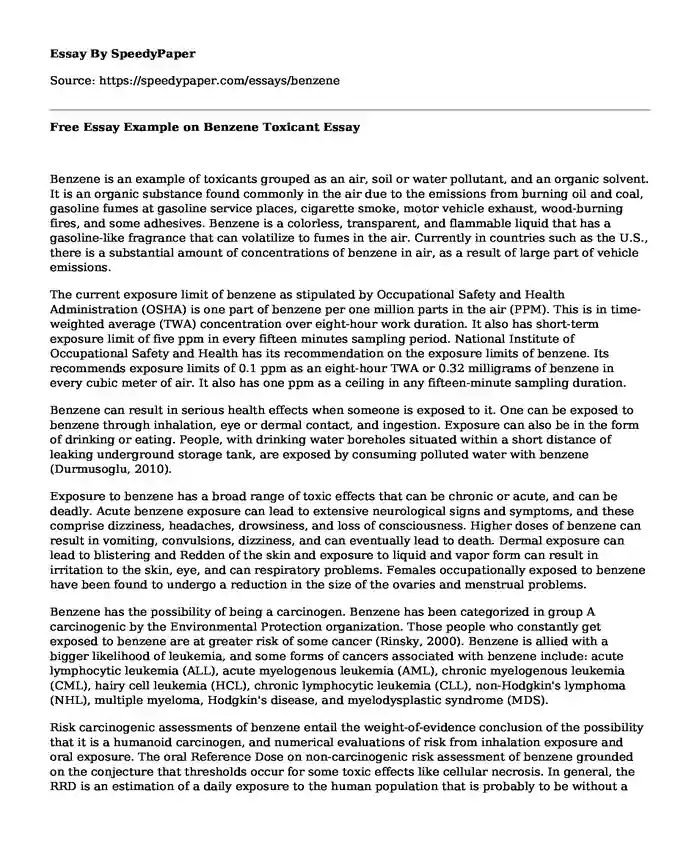
| Type of paper: | Essay |
| Categories: | Environment Air pollution |
| Pages: | 3 |
| Wordcount: | 592 words |
Benzene is an example of toxicants grouped as an air, soil or water pollutant, and an organic solvent. It is an organic substance found commonly in the air due to the emissions from burning oil and coal, gasoline fumes at gasoline service places, cigarette smoke, motor vehicle exhaust, wood-burning fires, and some adhesives. Benzene is a colorless, transparent, and flammable liquid that has a gasoline-like fragrance that can volatilize to fumes in the air. Currently in countries such as the U.S., there is a substantial amount of concentrations of benzene in air, as a result of large part of vehicle emissions.
The current exposure limit of benzene as stipulated by Occupational Safety and Health Administration (OSHA) is one part of benzene per one million parts in the air (PPM). This is in time-weighted average (TWA) concentration over eight-hour work duration. It also has short-term exposure limit of five ppm in every fifteen minutes sampling period. National Institute of Occupational Safety and Health has its recommendation on the exposure limits of benzene. Its recommends exposure limits of 0.1 ppm as an eight-hour TWA or 0.32 milligrams of benzene in every cubic meter of air. It also has one ppm as a ceiling in any fifteen-minute sampling duration.
Benzene can result in serious health effects when someone is exposed to it. One can be exposed to benzene through inhalation, eye or dermal contact, and ingestion. Exposure can also be in the form of drinking or eating. People, with drinking water boreholes situated within a short distance of leaking underground storage tank, are exposed by consuming polluted water with benzene (Durmusoglu, 2010).
Exposure to benzene has a broad range of toxic effects that can be chronic or acute, and can be deadly. Acute benzene exposure can lead to extensive neurological signs and symptoms, and these comprise dizziness, headaches, drowsiness, and loss of consciousness. Higher doses of benzene can result in vomiting, convulsions, dizziness, and can eventually lead to death. Dermal exposure can lead to blistering and Redden of the skin and exposure to liquid and vapor form can result in irritation to the skin, eye, and can respiratory problems. Females occupationally exposed to benzene have been found to undergo a reduction in the size of the ovaries and menstrual problems.
Benzene has the possibility of being a carcinogen. Benzene has been categorized in group A carcinogenic by the Environmental Protection organization. Those people who constantly get exposed to benzene are at greater risk of some cancer (Rinsky, 2000). Benzene is allied with a bigger likelihood of leukemia, and some forms of cancers associated with benzene include: acute lymphocytic leukemia (ALL), acute myelogenous leukemia (AML), chronic myelogenous leukemia (CML), hairy cell leukemia (HCL), chronic lymphocytic leukemia (CLL), non-Hodgkin's lymphoma (NHL), multiple myeloma, Hodgkin's disease, and myelodysplastic syndrome (MDS).
Risk carcinogenic assessments of benzene entail the weight-of-evidence conclusion of the possibility that it is a humanoid carcinogen, and numerical evaluations of risk from inhalation exposure and oral exposure. The oral Reference Dose on non-carcinogenic risk assessment of benzene grounded on the conjecture that thresholds occur for some toxic effects like cellular necrosis. In general, the RRD is an estimation of a daily exposure to the human population that is probably to be without a considerable risk of toxic effects during a lifetime (Leeuwen, 2007).
Reference
Durmusoglu, E. a. (2010). Health risk assessment of BTEX emissions in the landfill environment. Journal of hazardous materials, 870-877.
Leeuwen, C. J. (2007). Risk assessment of chemicals: an introduction. New York: Springer Science & Business Media.
Rinsky, R. A. (2000). Benzene and leukemia. New England Journal of Medicine, 1044--1050
Cite this page
Free Essay Example on Benzene Toxicant. (2020, Jun 10). Retrieved from https://speedypaper.net/essays/benzene
Request Removal
If you are the original author of this essay and no longer wish to have it published on the SpeedyPaper website, please click below to request its removal:
- Essay Sample on the Failure of VA to Offer Adequate Health Care to Veterans
- Free Essay in Education: Western-style Boarding Schools in China
- Free Essay Sample about Traveling
- Essay Sample Describing the U.S Food and Drug Administration
- Essay Sample in Education: Read and Write Learning Style
- Free Essay about the Ways States Use to Stop School Starting
- The Era of Enlightenment - Free Essay in Philosophy
Popular categories




